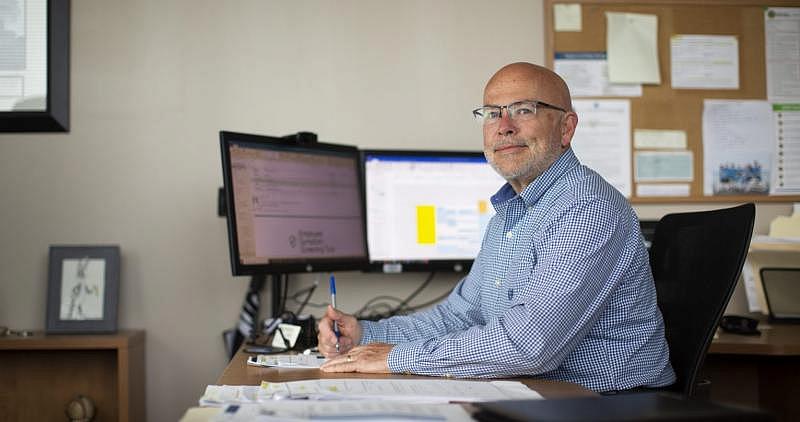Part 4: NC could look to other states for potential child welfare reforms
This article is part 4 of the four-part investigative series “Patchwork Protection” produced by Kate Martin for the USC Annenberg Center for Health Journalism’s 2020 Data Fellowship.
Her other stories include:
Part 1: Protection of NC children, families depends on the county
Part 2: Stories recount concerns with DSS agencies across North Carolina
Part 3: Structure of NC child protective services leads to inequity
Indicted former director resigns from DSS position, can’t work for county again

The North Carolina Department of Health and Human Services headquarters on the campus of the former Dorthea Dix state mental hospital in Raleigh.
Frank Taylor / Carolina Public Press
by Kate Martin and Frank Taylor
North Carolina is an outlier among the 50 states in the way child welfare services are organized.
Along with eight other states, North Carolina relies on county offices for on-the-ground decisions while the state’s Department of Health and Human Services serves in a largely supportive role, offering training and providing policy guidance.
In most parts of the country, the state, rather than counties, is in charge of child welfare. Georgia, a regional neighbor with a similar population, is one such state. Given concerns with child protective services in North Carolina, one option would be to emulate some of what seems to work well for states like Georgia, but this would require legislative action.
Going rogue
When North Carolina county departments of social services, administrators or social workers go rogue, or deliberately violate state or federal laws and policies, the state DHHS has no hiring or firing authority and can do little but watch, even when alleged criminality is involved.
In Cherokee County in 2018, then-DSS Director Cindy Palmer was placed on paid leave by the local DSS board for her role in a wide-ranging scheme to separate children from families using a form a judge later called unlawful. DHHS sent a team in to oversee the county’s child welfare programs during the crisis.
Palmer then resigned in order to accept a different job in the same office, while DHHS workers were still there and during an active State Bureau of Investigation probe into her criminal involvement. A state supervisor told workers in Murphy it was an “unprecedented situation” and to only talk to her if it was directly related to their jobs.
She has since been indicted and faces prosecution, yet county officials have declined to remove her from the agency.
Tom Rawlings, Georgia’s Division of Family and Children Services director, talked with Carolina Public Press this week about child welfare operations in his state.
In state-administered systems like Georgia’s, an official ignoring the law wouldn’t be a problem for long, Rawlings said, because the state has hiring and firing authority. But these policies in North Carolina lead to patchwork protection for children and families.
“I would find it difficult to work in a county-based system, especially in Georgia — we have 159 counties,” Rawlings said.
“If every county is its own fiefdom, you don’t get a lot of consistency.”
Georgia Gov. Brian Kemp appointed Rawlings to his post more than two years ago. Prior to the appointment, Rawlings worked in child welfare as an attorney and judge for more than two decades. Tom Rawlings is director of Georgia’s Division of Family and Child Services. Photo courtesy of Georgia DFCS.
He said multiple state agencies need to work together to overcome systemic inequities due to poverty or geography.
“The truth is, we know that all of the failures of the child welfare system are systemic,” Rawlings said.
“Very, very seldom does it boil down to one agency and certainly not one individual. The way you fix these issues is you take a systemic approach and make sure you are getting all parties on board.”
Timely data makes a difference
One proposed systemic fix was NC Fast, the state’s automated case management software that’s supposed to make tracking child welfare cases easier. Like many others in North Carolina, Wake and Buncombe counties spent a lot of money and time over the last decade preparing for the implementation of the system.
But with NC Fast still not working properly, Wake County is testing the waters for its own software until the state gets up to speed, Paige Rosemond, Child Welfare Division director in Wake County, said in a recent interview.
Rosemond worked for a time in Colorado, which has a state-supervised, county-administered child welfare system similar to North Carolina. She said Colorado’s robust case management system was essential to keeping children safe in a state with a major geographic barrier: the Rocky Mountains.
“I think children are safer when one is in place,” Rosemond said of case management software.
“You are able to access that child and family’s experiences and other counties as well. It’s essential. And I think it’s also essential in a state-supervised county-administered system — especially now with COVID — for our state partners to have their finger on the pulse of what is happening in county practice.”
Paige Rosemond, Wake County Division of Child Welfare director, works from her home office in Wake Forest. She’s concerned that the lack of an adequate statewide data system undermines child welfare in North Carolina. Alicia Carter / Carolina Public Press
The county recently posted a request for information from companies to see how much their own system, absent a state solution, might cost.
“We have been waiting on this solution now for a decade-plus,” Rosemond said, “and we still do not have a statewide automated case management system. And in the interim, my staff needs a case management system.
“We support the state and their efforts to make this happen. It can’t happen soon enough,” Rosemond said.
“We need a comprehensive system to be able to manage our work to ensure that supervisors are able to readily assess whether or not contacts have happened, what the quality of those contacts were, if we are meeting the various benchmarks necessary to effectively and holistically assess a family.”
If the state had a functioning automated case management system, Rosemond said, local caseworkers and state officials would have “extensive data available to them at their fingertips. Anyone could pull reports, create charts and focus more efforts on defining strategies to respond to the analyses.”
State-level officials could keep a near real-time pulse on child welfare in each county, down to the individual caseworker level, said Rosemond.
“As the state continues to struggle with staffing restraints, this type of tool would allow the state to better manage resources and provide greater oversight and support to counties based on their individualized needs,” she said.
Wake County social workers turn in some of their reports on paper, and they’re not alone, according to a report last year from the General Assembly’s Program Evaluation Division.
“Right now, you’ve got some counties that are just filling out the forms literally on paper, and then there are other counties that have their own computer system,” said Sarah Nienow, who at the time was the Program Evaluation Division’s lead evaluator.
The systems don’t “talk” to each other, she said. One of NC Fast’s selling points has been the ability to track children across county lines with unique identifiers.
Minnesota has such a system, and child welfare officers at the state level can monitor screened-out reports from the previous day — nearly in real time.
In Georgia, the court system also exchanges data with the child welfare system each night to allow judges and attorneys to look up information about each child and their families. Attorneys and judges can upload court orders. Caseworkers can see those records attached to family files. It’s a system that helps keep everyone informed, Rawlings said.
“I can look up my cases and have in front of me the basic data of the case,” Rawlings said.
“Even if there are some imperfections in that data, when you look at it statewide and compare state data to one county, then we can compare that county’s outcomes,” he said. “We can use that data to interrogate what is happening in each area.”
Rawlings said good data is essential to how his office fields concerns about problems in different communities across Georgia.
Anecdotes can turn into an exploration of the data, and he said comparing local information to state measures can start a dialogue with multiple agencies that could help fix the problem.
“Maybe the community feels that the county is not responding appropriately to cases,” he said. “It may be that the court is not doing things quickly enough.”
Hotline potential
When receiving a report of child abuse or neglect, social workers in all states must navigate an intake process before deciding whether or how to respond to claims. Depending on the danger to the child, social workers then categorize and respond to these cases at varying levels of urgency: immediately or within 24-72 hours.
Legislative evaluations of North Carolina’s child welfare system have said the state needs to respond more rapidly to calls for advice from child welfare workers and recommended a statewide technical assistance line staffed by experienced social workers.
Four years ago, legislators passed Rylan’s Law, which includes a provision to increase support for child welfare offices throughout the state. Legislators still need to authorize funds to pay for the mandates, which include opening regional state offices and a technical support hotline for social workers.
The state hopes to hire 15 people to work in these offices in different regions throughout the state, DHHS told CPP in an email this week.
Buncombe County Health and Human Services Director Stoney Blevins sits at his desk in Asheville. Blevins was asked to testify before the General Assembly last year about how social workers handled a case, but his hands were tied by confidentiality rules. Colby Rabon / Carolina Public Press
Stoney Blevins, director of Buncombe County Health and Human Services, said DHHS officials told him they thought the turnaround for advice from the hotline would be somewhere around 24-36 hours, which is not quick enough if there’s a crisis.
“Think of the 911 system,” Blevins said last week. “911 is a county-administered system, and 911 operators are trained exactly the same. They do the same work in tiny Graham County that they do in big old Mecklenburg County.”
Other states that already have hotlines are using them in additional ways that could also be emulated in North Carolina.
Minnesota adopted a child welfare hotline approach after a task force reported county and tribal agencies needed help deciding whether to remove children. Consultations are to be scheduled “for the earliest time possible,” and no later than 24 hours after the request.
Under current plans, the hotline in North Carolina would be used only by child protective services workers. Members of the public who want to report child abuse or neglect would still have to call individual counties to report those suspicions. The approach is like the system in Georgia before 2014, when changes were made.
When Georgia counties were responsible for taking child welfare calls, many reports of abuse or neglect went to voicemail, with county workers having to follow up later, said Jessica Loeding, director of communications for Georgia DFCS.
Following several prominent child deaths in the early 2000s, Georgia created a statewide hotline to report abuse, answered 24 hours per day, in 2014.
Unlike the one planned in North Carolina, the Georgia hotline allows the public to connect with the state. Child welfare workers in Atlanta take reports and then send recommendations to local child welfare offices for further investigation. The hotline now answers calls within an average of 44 seconds, Loeding said.
Rawlings noted that the system in Georgia needed to be flexible and communicate well with social workers in the counties to make this work well.
Following the implementation of Georgia’s statewide hotline, foster care placements nearly doubled, from around 8,000 in 2014 to more than 15,100 children three years later, data from DFCS shows.
“Our centralized intake was doing a lot of immediate referrals,” Rawlings said. Foster care numbers dropped after “we really started focusing on safety and removing children only when there was a significant safety threat.”
Because intake in Georgia is completed at a statewide level rather than in each county, Rawlings said the state was able to pinpoint the problem and remedy it quickly.
“A state-controlled system is very good, but only if you are listening to folks in the local community,” he said.
“We have the ability to listen to the front line across the state and tweak the policy based on feedback from the folks who are closer to the work.”
Georgia’s system also relies on a timely examination of data about removals, calls and other indicators. DFCS officials travel around the state to talk with local child welfare and judicial workers about their data. They examine child removal rates along with contributing factors to those removals, most of which are for neglect, he said.
Addressing regional disparities
From Murphy to Manteo, and West Jefferson to Wilmington, North Carolina social workers and their bosses are supposed to follow state and federal rules to protect children and preserve family rights.
But systemic issues are at play, where resources available in many urban areas are not plentiful or present in some rural settings. Social workers leave lower-paying counties for those that pay more.
Child welfare lawyers have said rural areas don’t have mental health resources, and parents already struggling with finances are told to pay for parenting classes in some areas of the mountain west.
The county-administered system leads to separate and unequal resources for children throughout the state.
But other states have also tackled that problem by providing more staff or other help in poor communities.
Rosemond said when she worked in Colorado, another county-administered, state-supervised child welfare system, the state also faced a staffing shortage in some areas.
“The state provided the funding for (full-time employees) in our counties with the greatest need,” Rosemond said. “There’s another example of how the state needs to … ensure that our families and children are receiving equitable services, regardless of their geographical location in North Carolina.”
However, such plans require robust funding from the state, and legislators may not all agree on a solution.
“The state can’t do everything for everybody,” said N.C. Sen. Joyce Kraweic, R-Forsyth, this week.
“I know that it’s very hard to keep social service workers, regardless of the pay. I mean, even in the counties that do pay a lot more, they have huge turnover as well. So, I think it’s just as much the stress of the job as it is the pay — and it is a very stressful job.”
However, in Georgia, Rawlings said the state-administered structure of services gives him the freedom to provide more help to areas in the state that need it.
“If we come across a county where there are a significant number of removals for mental health issues, we can work with that county to build up the resources they need,” Rawlings said. “We are able to shift some funds around.
“If we allowed each county to provide these services, you would have a much greater discrepancy than we already do. That discrepancy is reduced to some extent due to the fact that we have a statewide system.”
Editor’s note: This article is part 4 of the four-part investigative series “Patchwork Protection.” This project was produced for the USC Annenberg Center for Health Journalism’s 2020 Data Fellowship.
[This story was originally published by Carolina Public Press.]
Did you like this story? Your support means a lot! Your tax-deductible donation will advance our mission of supporting journalism as a catalyst for change.

